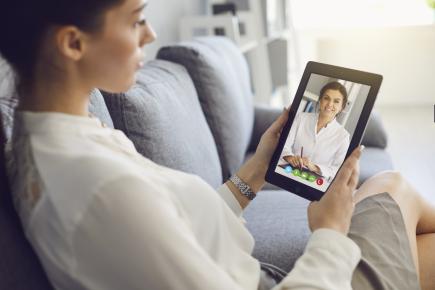As technology advances so has discussion about the possibilities of telehealth. In fact, ahead of the pandemic, in December 2019, the inevitability of telemedicine in optometry was being discussed.1 The declaration of COVID-19 as a global pandemic in March 2020 forced initial, and in some cases with second and third waves of infections, repeated, stay-at-home orders. Healthcare, including Optometry, has had its hand forced to embrace a flexible and different approach to clinical practice. As mass vaccination programs gain pace worldwide, a return to a more recognizable ‘normal’ way of life appears to be on the horizon. Looking out to the future, how has this past year changed clinical practice, and what are the likely positive effects that may linger, becoming part of the ‘new normal’ for Optometry practice moving forward?

With practices needing to close to all but emergency care in the first few months of the pandemic, the focus on virtual consultations was present early on. Information on the key aspects of providing virtual services was made available to eye care professionals (ECPs), an example of which is the position statement on telemedicine from the American Optometric Association.2 While it is widely recognized that many elements of clinical practice absolutely require in-person consultation, and limitations exist for imaging the eye remotely,3 the wider introduction of telehealth has added much-welcome flexibility for ECPs and patients. A recent summary highlighted some of the pros of telemedicine in Optometry, sharing examples of being able to triage a patient ahead of being seen in-person, and being able to spend time virtually with patients with chronic conditions to check in on their progress and reissue ongoing medications.4 For US ECPs, the ability to bill for this time has been recognized, enabling clinicians to spend time on these types of consultations where they may have preferred not too before.4
For contact lens practice specifically, there are of course elements of the patient journey that cannot be conducted remotely, many of which are related to assessment of CL fit, particularly of complex, specialty lenses. In summarizing the landscape of contact lens practice one year into the pandemic, Naroo et al. detail the stages required for lens fitting, noting of the eight they define, that slit lamp examination of the cornea, preliminary measurements of corneal curvature or ocular topography, and an on-eye lens trial and fit assessment all still require an in-person appointment.5That said, the experience of the last year has opened up possibilities for other stages in the patient journey to be conducted remotely. They include handling initial enquiries to discuss patient suitability for contact lenses, and the collecting of relevant history and symptoms.5 While teaching a new wearer how to apply, remove and care for their contact lenses still requires in-practice time, the need to reduce contact time with patients driven by COVID-19 has accelerated use of additional supporting materials. For example, on-line video tutorials can be recommended for viewing, ahead of, or during, the appointment to reduce time spent in close contact with staff. Those same videos and other supporting materials are useful once the new wearer is home to help them gain confidence with handling. In fact, it is known that difficulties with handling are one of the main reasons new wearers drop out within the first year, the majority of which happens within the first 2-3 months.6,7 Remote consultations are perfect for early follow up of new wearers to check in with how they are coping with handling and to ensure their lenses are performing well in terms of comfort and vision.
Required changes in practice to support the safety of both patients and staff from exposure to COVID-19 have been well documented,8 and widely adopted by the profession. What, of those, are likely to stay? Facemasks, personal protective equipment (PPE) and large breath shields on equipment whilst necessary during the pandemic, also hinder some clinical practices and can make communication more challenging with some patients. Once safe and advised to do so, it would seem likely that these additional safety measures may stop. Other aspects however, such as a more visible focus on hand hygiene for all, and the enhanced cleaning and disinfecting procedures employed throughout the day may remain, both as an example of best practice and as a reassuring sign for patients.
Eye care professionals (ECPs) have demonstrated remarkable resilience and adaptability over the last twelve months in order to continue providing high quality care for their patients. The enforced need to embrace telemedicine has likely resulted in a lasting shift towards integration of this technology. Increased use and focus on this area is also likely to accelerate the development of more technology and services becoming available too. Those, coupled with the all-important in-person assessments necessary for routine eye health and contact lens practice, will ensure the ECP continues to be best-placed to offer the very best all round care for their patients.
References
1. Hill G. Telemedicine in optometry: Is it inevitable? ; 2021 [updated 2021. Available at: https://www.optometrytimes.com/view/telemedicine-optometry-it-inevitable. Accessed: 15 Apr 2021];
2. AOA POSITION STATEMENT REGARDING TELEMEDICINE IN OPTOMETRY. 2020 [updated 2020. Available at: https://www.aoa.org/AOA/Documents/Advocacy/position%20statements/AOA_Policy_Telehealth.pdf. Accessed: 15 Apr 2021];
3. Nagra M, Vianya-Estopa M, Wolffsohn JS. Could telehealth help eye care practitioners adapt contact lens services during the COVID-19 pandemic? Contact lens & anterior eye : the journal of the British Contact Lens Association 2020;43:204-7.
4. Brujic M, Kading DL. IS TELEMEDICINE A NEW NORMAL? ; 2021 [updated 2021. Available at: https://www.clspectrum.com/issues/2020/september-2020/is-this-the-new-norm. Accessed: 15 Apr 2021];
5. Naroo SA, Kapoor R, Zeri F. Times they are a-changin for contact lens practice. Contact Lens and Anterior Eye 2021:101445.
6. Sulley A, Young G, Hunt C. Factors in the success of new contact lens wearers. Contact lens & anterior eye 2017;40:15-24.
7. Sulley A, Young G, Hunt C, et al. Retention Rates in New Contact Lens Wearers. Eye & contact lens 2018;44 Suppl 1:S273-S82.
8. Zeri F, Naroo SA. Contact lens practice in the time of COVID-19. Contact lens & anterior eye 2020;43:193-5.








